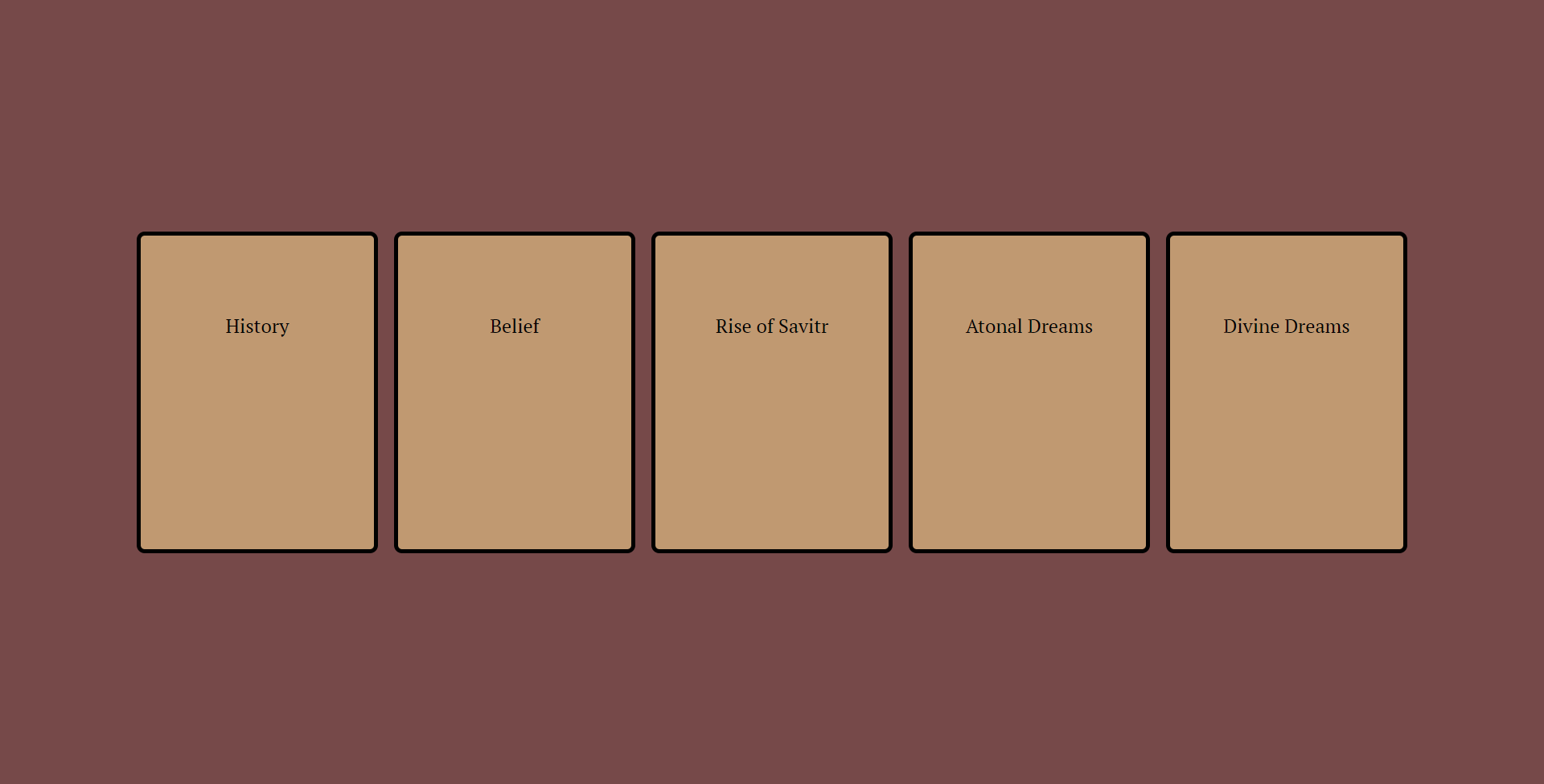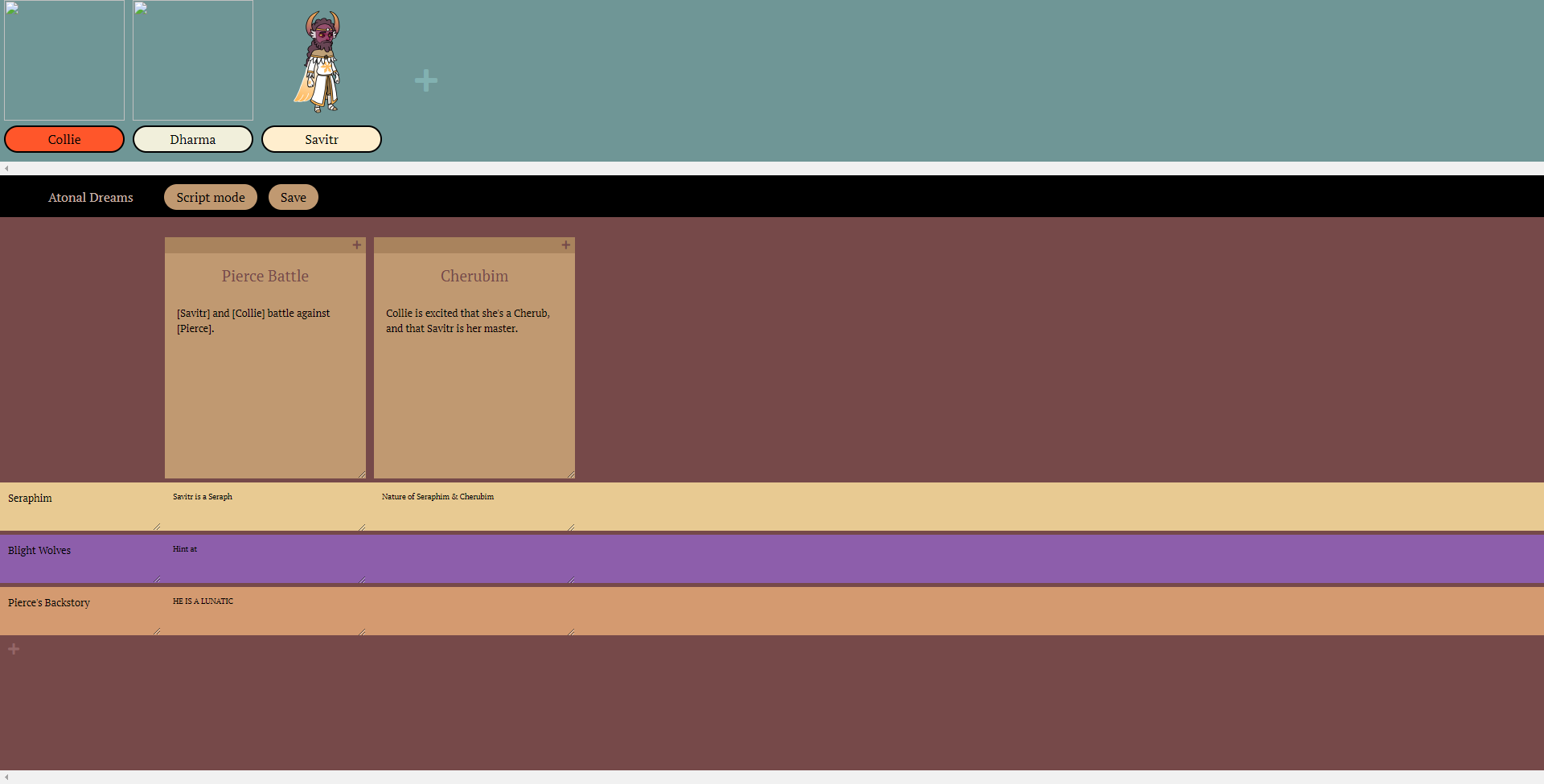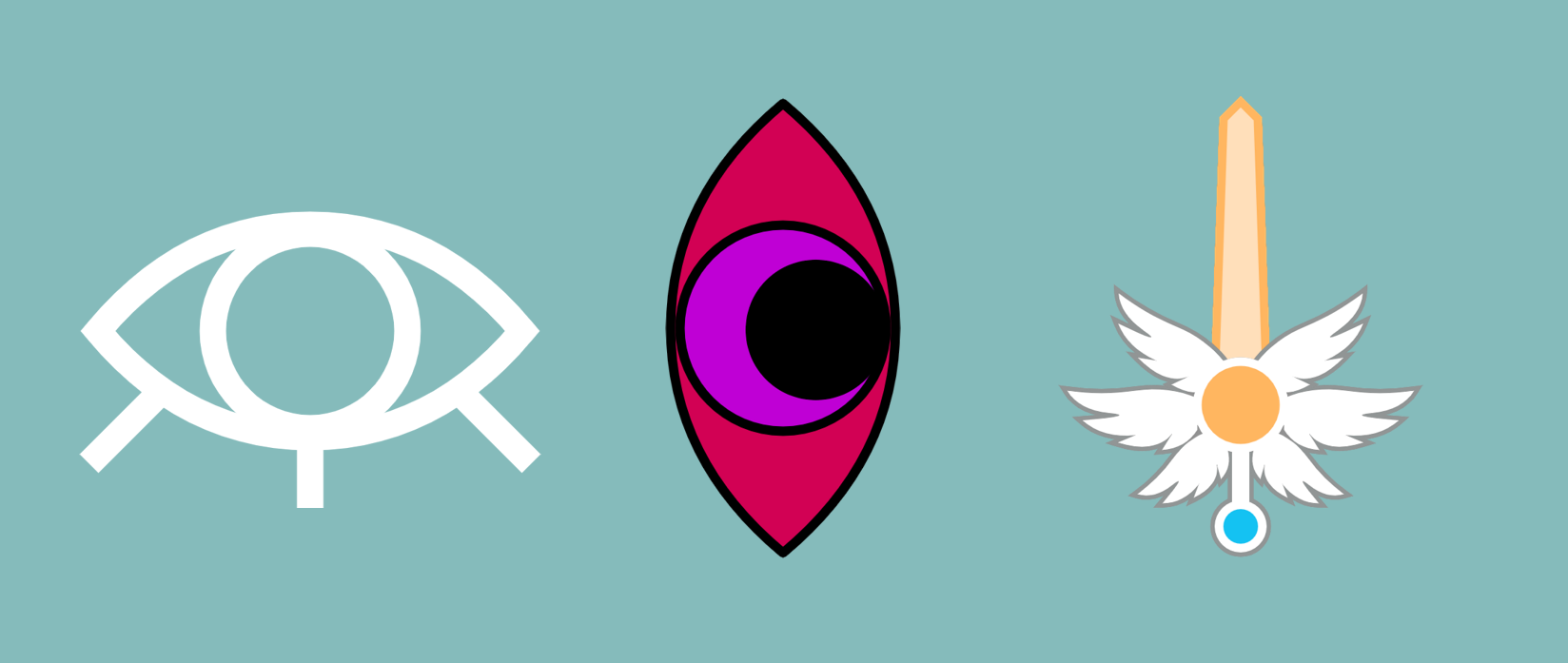DEVELOPMENT
2,119
Atonal Dreams Weekly Update 21 - Alora Fane Lore
5 years ago - Edited 5 years ago
I've been trying to sort out the whole Divine Dreams + Belief + Atonal Dreams story in a way that makes sense to me! I've also come up with some symbols for important concepts during the planning process.
Atonal Dreams began as
Divine Dreams, a reimagining of
MARDEK's essential plot, which I started planning late last year. I have some Word documents - like the ones I included in the Steam MARDEK DLC - with hundreds of pages of planning about characters, story events, world lore, etc of Divine Dreams. I've got several specifically for Atonal Dreams, too, and these are what I've been working with while writing the script recently. They're full of brainstorming and revisions and have information scattered all over, though. For example, one contains a list of events, and an entirely separate one has the script for each of those events, meaning if I want to revise the order of events I have to edit both, and I keep having to go back and forth to check what I'm doing.
The intended purpose of Atonal Dreams was to gauge whether it'd be worth working on the rest of Divine Dreams. So I'm trying to write it such that if I did make the rest of the series, a lot of things it introduced would be expanded on. It's kind of an origin story for several of the characters, but for that to work, I need to know what'd happen with them later!
Atonal Dreams' intended order of events has remained the same since my initial plans for it, though as I've been working more on the script these past couple of weeks, I've refined a lot of things to flow in what I feel is a much more satisfying way. Or I've changed some details that make later events more sensible and less out-of-nowhere. I'm still unsure about some bits in the middle, though, and some bigger aspects of the overall character arcs and how they tie in to Divine Dreams.
So I've been trying to look through all the notes I have, to tie things together... but everything's so tangled! I was getting a headache trying to make sense of everything.
I tried starting some new documents to lay out everything that I have in some clear final form, but I couldn't decide how to lay out in the information in a way that was easy for me to make sense of. I tried Word documents, a spreadsheet... but it all feels so messy.
There are a few 'story planner' tools out there for organising narratives through linked charts or whatever. I looked at a few, but they all cost money, or were built for amateur novelists of the sort who plan to write N words a day and such. They didn't really feel suited to exactly what I needed.
So - not for the first time - as I was unable to find the ideal tool for my needs, I decided to use my AMAZING DESIGN SKILLS to make my own!
![]()
I've organised everything into these five STORIES. Belief, Atonal Dreams, and Divine Dreams would be actual games, while the other two (History, Rise of Savitr) are important events that happened outside the games but would be referenced heavily and fundamental to their plots or character psychologies.
![]()
Each STORY is made up of SCENES and THREADS.
Each SCENE has a title, a brief description of generally what it happens in it, an associated script of any dialogue, and brief descriptions for how it ties into each of the story's threads.
The THREADS are the main reason that I've made this tool for myself. I wanted several different ideas to be gradually explored across several different scenes, but couldn't figure out how best to lay that out such that I could keep track of everything, how often each idea was mentioned, whether the flow made sense, etc.
Each thread here is a row, and each scene has its own column which can be filled in. I'm hoping that by scrolling horizontally, I'll be able to see quite easily how each of these threads are explored throughout the story. Makes sense to me!
![]()
By shifting to Script Mode, I can edit the scripts for each of these scenes in a way I find more enjoyable than a Word document. Hopefully it'll mean it'll be fun for me to continue writing the rest of the script! I'll also code it so that it can export directly to the correct format for the game so then I don't have to tediously copy and paste every line individually.
Since I've got a list of characters, and each line is tied to a character, I can also look at some stats, like how many lines each character has. That might be interesting or useful.
I only built this a couple of days ago, so I've not yet added all the information to it. What I intend to do is add specific dialogue scenes for Atonal Dreams (I'll copy over what I've already written out in Word documents), with scripts, but for the other four Stories, I'll add a few big, vague, important events and threads; I'm definitely not going to be writing any scripts at this point, or planning them down to specific scenes.
This script writing bit is taking longer than expected, but I'm hoping having a clearly-laid-out plan will really help in the long run. I feel that having a lot of story and lore planned in detail right from the start will help the game appeal to the sort of people who love immersing themselves in stories' lore, reading wikis about their worlds, etc. It takes time to plan something like that though!
If you write stories yourself, how do you plan them? Do you use any story planning tools, planning documents, or do you just keep a plan in your head and write things out as you go?
![]()
![]()
Here's another thing I made while planning this week!
Symbols and icons are an effective way of communicating complex concepts simply and instantly, so it's valuable to have a few for key concepts or organisations. I've already got the Aster (the flower thing that represents this site and which I use as my avatar in most places), which represents the world of Alora Fane, and the gods specifically, but I hadn't sat down and finalised any other symbols for the Alora Fane world until now.
The left one here represents the
drealm in a general sense. It might be called something like the
Dreamer's Eye, or maybe just
The Eye. It's meant to be the sort of symbol that any non-artist could easily draw with their finger in the sand, and which everyone would instantly recognise. Something old that emerged naturally over generations, like a language, not really
designed. I'm not sure whether or not it should have the 'eyelashes' at the bottom; they're only at the bottom so it looks like an eye that's simultaneously closed and open, but maybe it's not clear enough and no lashes would be better. Or maybe both variations are used, with one maybe being more formal than the other.
The middle one is
Blight's Eye, the logo of the
Blight Wolves, and the one on the right is
Seraph's Sword (which I might rename), the logo of the
Seraphim.
They contrast each other in a few ways:
Order & Chaos:
Seraph's Sword is meant to look carefully and ornately
designed, not like something anyone could accurately scribble in the dirt, while Blight's Eye is made of simple shapes. Seraph's Sword represents the carefully built societies of the material world, while Blight's Eye is literally the Dreamer's Eye - an ancient symbol representing the absolute chaos of the drealm - turned on its side.
Male & Female:
They look like genitals! Seraph's Sword is a penis thrust proudly upwards, while Blight's 'Eye' could be seen as a vagina which hints at birthing darkness. I know some people react weirdly to anything about sex or sexual organs, but they've been important in symbolism throughout history. Also, mythologically, males tend to be symbolically associated with Order while females are Chaos; in Christian mythology, it was Eve who defied Yahweh and got the human race expelled from the Garden of Eden, to give one of many examples. It's something Jordan Peterson has talked about quite a bit, to which I've seen some people calling him a MISOGYNIST!!! because they see chaos as bad (he's only describing how ancient myths depict them anyway, not his own opinion). But chaos is creativity, revolution, freedom, progress. More women tend towards liberal politics, which is more chaotic than conservative order. Neither chaos nor order are bad or good, though in extremes both are terrible.
Sun & Moon:
Alora Fane doesn't have a sun or a moon, because it's not a planet (it's complicated), but the concepts still exist within the world for different reasons. The word 'lunatic', for example, means 'crazy person' in our world and has associations with the moon, while in Alora Fane, the Blight Wolves were founded by a shaman called Lunaia, so the word is a reference to her. A crescent moon can be seen in Blight's Eye, and other examples of the symbol in Alora Fane would be a reference to this (rather than this referencing the moon). Wolves and werewolves also have associations with the moon in general! The Seraphim one doesn't 'look like' a sun, but hopefully you can see it has that general look about it. Proud, bright; the wings have a sunburst look about them, and the golden core is definitely sunny.
Other details:
Blight's Eye is looking off to the side, rather than staring directly at the viewer. Lunaia founded the Blight Wolves to honour Blight the Betrayer, who defied the gods' orders and freed them from their tyranny (and who was killed by Seraph, the founder of the Seraphim, for this). This looking-off-to-the-side is chaotic, defiant, and permissive, to contrast with the authoritarianism of the Seraphim (and the gods).
The Biblical seraphim are described as having six wings, and the Aster has six petals. Seraph's Sword makes reference to both. In the Aster, the central circle represents the Nexus, from where the gods effectively ruled and oversaw the world. It's also where souls would eventually transcend after learning enough over many lifetimes, so it's kind of like Heaven. In the Dark Age following the Fracture, it's spoken of only as a legend rather than a real thing. The gods are gone, but the Seraphim aim to maintain order in their absence, so the golden core represents the Seraphim taking the gods/Nexus' place. The smaller blue circle in the hilt represents the Cherubim, who have started on their path to rise up and become Seraphim.
The blade is a resonar, but it also looks like the Obelisks that I had in Alora Fane: Creation and Taming Dreams a few years ago. Back then, I intended those obelisks to be artefacts of the gods, which they set up to prevent the miasma from forming into monsters in places where people lived. Now that I've revised miasma as drealm flowing into the world through 'wounds' it sustained during the Fracture, it wouldn't make sense for the gods to have made them because the whole point of the Fracture was that the link to them was severed. Perhaps the Seraphim have set up obelisks to control the miasma, and they use the same crystal technology as the resonars? That's an interesting idea, I think! Seraph's Sword, then, represents both the larger obelisks in settlements, and the personally-wielded resonars.
![]()
I'm going to spend the next week organising all the planning I've got into this new tool that I've made for myself. Hopefully by the end of it, I'll have a much clearer idea of how everything in Atonal Dreams and Divine Dreams ties together! Like I said, I'm intending to plan only Atonal Dreams at the level of events, but I'd like to clean up my notes for Divine Dreams and Belief so that I have at least their major story beats laid out in a way that's easier for me to reference than the disorganised mess of disconnected documents I have currently. I'll sort out the specifics once we've seen how well Atonal Dreams has been received.
...Though it could very well do as well as Sindrel Song - or worse! - and I'll just be wasting my time with all this... but I might not be wasting my time and I'll be able to make Divine Dreams and/or Belief quite quickly if I know exactly what's going to happen in them!! Who knows.
Anyway, I wish I had more interesting progress to talk about, but planning takes time! J K Rowling spent like 5 years planning Harry Potter before writing any of it, I think? Something like that. Many other authors surely spend as long or longer only for what they eventually produce to be a complete flop, I know, but I do think it's important to spend some time planning the lore and story in detail if you want to do them well. I'm hoping to be done with my planning and scriptwriting in weeks or less rather than years, though!









5